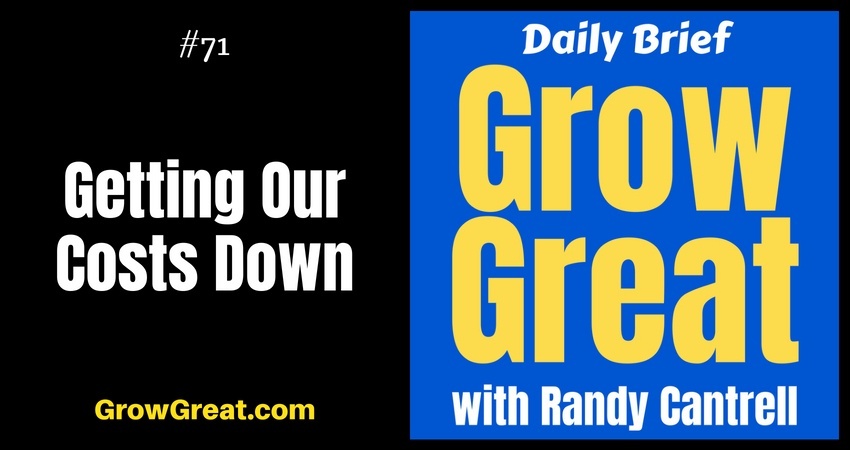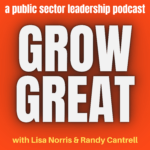Podcast: Play in new window | Download (Duration: 14:03 — 14.0MB)
Subscribe: Apple Podcasts | Spotify | Email | RSS | More

Some people think you just sell your way out of every problem. More sales equal more money. More money means less trouble. Fewer problems. It doesn’t always work that way though.
You know if you’re more driven by the top line (revenue) or by the bottom line (profits). You can be top line driven and still care about controlling costs. They’re not mutually exclusive. It’s largely determined by what you believe in most, and what you enjoy doing most. CEOs and business owners who have a gift of selling tend to focus on that. It’s fine. You don’t need me to tell you it’s okay. But I just did. CEOs and business owners who lean more toward details and efficiencies likely pay closer attention to the bottom line. This isn’t about making a judgment on the rightness or wrongness of either focus.
Balance. Every business needs balance. A proper focus on the revenues or sales while maintaining focus on the bottom line profits, which must take into account all those expenses. Costs.
In personal finances, you can save your way toward wealth. I’m sitting in an Economics 101 class in my freshman year of college. There are a few hundred kids in this class. Big auditorium, stadium type seating. The professor had teased the class, telling us he would be informing us how we could all become millionaires. Many of us who regularly cut the class attended. How can you cut a class when it’s going to be about how to become a millionaire?
Here was the formula he taught us that day. Don’t get married. Get any job earning any reasonable amount of money. Don’t fret about getting a high paying job. Live in the most austere way possible. Don’t buy stuff. Just have a modest lifestyle, living as bare bones as you can. Save at least $20,000 a year. Earn $40,000, then you save 50%. Earn more, save more. At least that’s what he encouraged us to do. Work 50 years and you’ll have $1,000,000.
Needless to say, it wasn’t the formula we were looking for. We were sorely disappointed in this wealth building strategy. By the way, we cut his class much more frequently after that lecture. To say we were hacked off would be to mildly understate how angry we were at being dupped into attending class that day. But it stuck with me. You can save your way to wealth in your personal life.
Makes sense that you should be able to save your way to business prosperity, too. But you can’t. And for good reason. Revenue (the equivalent of personal income) isn’t predictable. If you get a job earning $40,000 a year you know you’ve got $40,000 coming in each year. You can implement the strategy our professor told us about. But in our businesses, we have fluctuating revenue. And we lack the discipline to not let our expenses or costs fluctuate with it. When sales are strong, we spend more readily. When sales are tight, we reach for our belts to tighten things down.
Discipline is the key to personal wealth building success and to our corporate success.
Returns. As you man the helm of your business you must focus on generating revenues, cash, and customers. Cash is king. Always has been, always will be. Cash flow is the fuel you need to stay aloft. Run out of cash and you’ll crash. Customers? Well, try getting revenues and cash without them. Sales. Cash. Customers. They’re all tied together.
Some costs have a fairly easy ROI (return on investment) to calculate. Customer acquisition costs, for example. How much does it cost your company to acquire a customer? I know service-based businesses, including trade-type businesses, who have a very low customer acquisition cost. Maybe they’ve been operating so long they’ve got a strong book of business, with tons of referrals. They market, but they don’t buy advertising or spend any significant money to get business. Other businesses have high dollar real estate investments in a physical location designed to be attractive to would-be customers. They spend thousands of dollars each month to attract customers. Their customer acquisition costs are significant.
I’m picking on this particular expense for good reason. You need customers. You’ve got to get them some way, somehow. You can’t just spend your way to success. You can’t save your way to success either. The math has to work to your favor or you’ll soon be out of business.
You could drive down the expenses of acquiring customers. For example, you could eliminate all advertising. If you’re spending $30,000 monthly in advertising you could be lulled into thinking, “Great, that’s $30,000 I can add to the profits.” That’d be true if sales could be maintained (like our example of $40,000 personal income). But we both know if we eliminate all our advertising our sales will likely plummet. So that’s not a sound approach.
Getting costs down while maintaining or growing sales. That’s the key. Easier said than done, but it can be done. WalMart has led the way for decades.
In our example, the key is to drive down our customer acquisition costs. We can do it in 2 ways. We find ways to gain more customers while not increasing our costs. And, or, we find ways to maintain the rate of customer acquisition without spending as much. Maybe you focus on your closing ratio (how many prospects you’re able to convert into customers). If your current customer acquisition costs are based on closing 4 out of 10 prospects, then you can focus on finding ways to get 5 or more out of 10 while spending the same amount.
Making your dollars go further. Business success depends on this investment/expense activity. Sometimes it’s getting costs lower. Other times it’s getting more out of the costs.
Advertising that garners more prospects – dollar for dollar – is more valuable than advertising that brings in fewer prospects. But we can be tempted to avoid the math. We fall in love with things. We get sentimental. What once worked stops working, but we don’t adjust. The retailer who has historically spent advertising dollars on newspaper, radio or TV continue to spend money there, even though the dollar value is awful. The math is the math. It’s not just about the math, but we can’t avoid looking at the math either.
“I can’t afford it,” is a common refrain. You hear it from your prospects. You say it to your suppliers. We all use it even though it’s not always (or even often) true. What will the money spent get us? Returns. It’s about our discipline to manage the real returns we get. If you spend $35 to get a customer and one customer is worth $50, then you’ve got a math problem. The remaining $15 of profit have to be enough to cover all the other expenses and leave you a sustainable net profit. That’s not likely going to happen. But if you spend $35 to get a customer who will spend $3,000 then you’ve got the math working to your favor.
Basic. Fundamental. But quickly forgotten by too many business owners who let costs grow out of control. Expenses have a way of creeping up, and up and up. You can’t afford to ignore the math of the return you’re getting on those expenses. Every expense has a return. Yes, those health insurance premiums you hate to pay garner a return. Unless you offer those benefits the quality of your team falls. Can you drive that down if you focus on it? Yes. Everything can be driven down with a bit of attention. I’ve never seen it fail. When we pay close attention to something, we’re able to accomplish magical things.
Miles per gallon. Attack your expenses line by line with an MPG mindset. Make the dollars take your further. Make your advertising foster more sales. Make your insurance premiums garner bigger benefit, greater peace of mind. You know my attitude about expenses…put every expense on trial for its life. Make it earn its spot on the books. If it can’t, then adjust it so it can.
My personal objective with all my clients is to provide a 10x return. While I can’t guarantee it, because I can’t guarantee the effort clients put into the work…I am determined to do everything possible on my end to help clients generate at least $10 for every dollar they invest in my help. I’m happier if we can get it closer to $20. That math is important. For me and my clients. I want to earn sufficient profits so I can render the best service possible. And so I can operate a sustainable business. And I want it to be a no-brainer, drop-dead easy decision for my clients. If I’m able to deliver a ten dollar bill for every dollar bill they give me, then it’s an easy decision for them, an investment they’re anxious to make.
Take the time to figure out if the line item expenditure is earning its keep. What kind of return are you getting? Calculate it.
Now figure out how you can elevate that return. If you can’t, then figure out if you can get an equal or better return by lowering that expense.
As you go through your P&L line by line you’re going to discover some things that are completely worthless. Costs that can be completely eliminated.
You’ll find others that are so much higher than necessary, you’ll be angry at yourself for not looking at it more closely. Regularly.
I’ve seen business owners operating large multi-million dollar businesses neglect to pay close enough attention only to find gaping holes where profits were just pouring out onto the ground. I’ve seen owners unearth some horrible internal thefts, too. Your business isn’t too small or too large to benefit from a closer examination of costs with the intention of making every dollar go further to propel your company to new heights of success.
Tracking is important, but not if you’re failing to pay attention. Ignorance is not bliss. It’s deadly. Know the numbers. Know what they mean and how important they are to your operational success.
Be well. Do good. Grow great!

Listen to the podcast
 About the hosts: Randy Cantrell brings over 4 decades of experience as a business leader and organization builder. Lisa Norris brings almost 3 decades of experience in HR and all things "people." Their shared passion for leadership and developing high-performing cultures provoked them to focus the Grow Great podcast on city government leadership.
About the hosts: Randy Cantrell brings over 4 decades of experience as a business leader and organization builder. Lisa Norris brings almost 3 decades of experience in HR and all things "people." Their shared passion for leadership and developing high-performing cultures provoked them to focus the Grow Great podcast on city government leadership.
The work is about achieving unprecedented success through accelerated learning in helping leaders and executives "figure it out."

